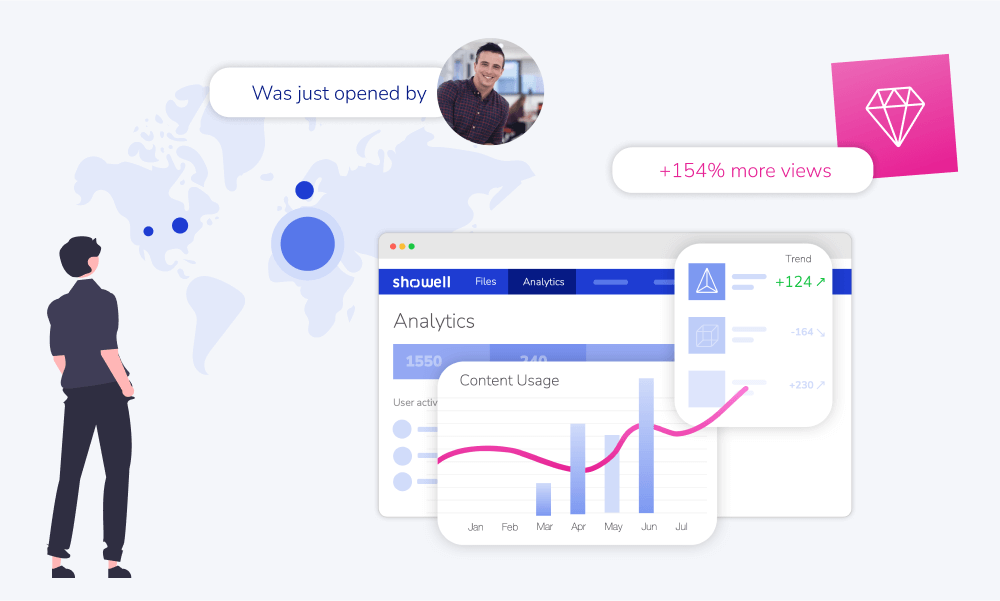Lacking content tracking means missing out on valuable insights from your sales collateral. Without it, you have no way of knowing what works and what doesn't until you receive feedback, if you even receive any at all.
Nowadays, it just doesn't make sense not to gather data and use it to refine your approach to cold calling, pitching, and closing deals. For all the technological savvy we have, why shouldn't content tracking be applied to every stage of selling?
Coupled with sales enablement, this fact-finding tool is vital for remote selling as both sales and marketing can use it to align with buyers' needs and pivot sales strategies when the time comes.
What is Sales Content Analytics?
Do you know what sales content your sellers use, or what your buyers skip and actually read? Did you know that a staggering 90% of sales content often goes unused?
By delving into sales content analytics, you gain critical insights into the effectiveness of your sales materials and how your team utilizes them. This knowledge helps you to focus your resources on creating content that truly resonates and drives performance, ensuring your efforts are aligned with what works best. etc.
|
💡 If you're wondering what is the most effective and efficient way how to deliver sales content to your team, we got you covered. Find out The Best Way to Provide Content to Your Sales Team. |
The Value of Sales Content Analytics for Sales and Marketing Teams
The value of sales content analytics lies in its ability to help not only sales leaders but also marketing teams. These insights can provide valuable information on what types of content are most effective at different stages of the sales process.
This allows your team to create more targeted, relevant, and effective sales materials tailored to their specific audience.
For Sales Leaders
Get an overview of how your sales representatives perform and use your sales collateral. You can then take advantage of these insights to improve your sales strategy and collaterals.
For Content Creators and Sales Support
Discover which content is the most effective and used the most. Be more efficient by focusing your efforts on what works and developing content based on data.
For Sales Representatives
Take the guesswork out of your sales work! Understand how your buyers are interacting and consume the content you share with them.

3 Reasons Why You Should Start Using Sales Content Analytics
Tracking sales content performance isn't just about measuring clicks and conversions. It uncovers behavior insights your sales team never had access to before. This intel helps you and your reps truly understand your buyers' needs and preferences.
Imagine your reps armed with this knowledge. They can craft targeted messaging that resonates on a personal level, driving significantly better results.
Sales content analytics goes even further. It ensures your sales teams, dealers, and distributors are all on the same page, following your established sales guidelines. Here are 3 reasons to start using sales content analytics:
1. Identify which sales materials bring the most value
Sales content performance analysis helps you identify and remove outdated collaterals. This includes content that salespeople no longer use, material that doesn't reflect current market trends, and pieces that fail to resonate with your buyers.
Benefits for Sales Leaders:
By analyzing these insights, sales leaders can pinpoint areas where content excels and identify opportunities for improvement. This deeper understanding of buyer preferences and behaviors unlocks the ability to create highly targeted content that resonates with their needs, ultimately driving conversions.
Benefits for Sales Representatives:
Sales reps become more effective by ditching the guesswork. Data and insights on how buyers consume shared materials empower them to tailor their approach for better results.
Benefits for Distributors:
Sales content performance insights empower distributors to effectively execute reselling plans and identify areas needing support or activation. They can also help identify and replicate the winning strategies of top performers.
There are several ways to analyze and measure the effectiveness of sales content, such as content engagement metrics. This involves measuring how long buyers spend viewing or interacting with sales content or how often it is viewed or shared. You and your sales teams gain solid information to understand what serves your buyers’ needs best at a given stage in the sales process.
2. Understand how your sales content is being used by a person, team, distributor, or geographical location
Understanding how sales content usage differs by salesperson, sales team, distributor, or geographically can provide valuable insights into the effectiveness of sales content and the preferences of different audiences.
Content Usage: Sales Reps and Sales Teams
For example, analyzing how different sales teams or salespeople use sales content can help identify best practices and areas for improvement. This can involve looking at metrics such as how long salespeople spend on each piece of content, how often they use or share certain types of content in sales meetings, and how well different types of content perform in terms of engagement and conversion rates.
In addition to that, this ensures your sales reps and sales teams follow your sales playbook. When it’s time to scale your sales efforts, these insights provide an overview of your sales reps’ and overall team performance.
|
💡 Bonus Tip: You can see the activity levels of your salespeople from the sales content analytics. Learn more about Showell's Sales Content Analytics. |
Content Usage: Distributors/Channel/Partner Sales
Managing content usage across distributors, channel partners, and your internal sales teams can be a monumental task. Keeping everyone on the same page often requires multiple meetings per week.
This is where content tracking can add value with external visibility. Not only can you see when they are selling but how dealers are executing reselling plans, how they are performing, and if they’re actively working on your portfolio.
You’ll also be able to see what your internal and external teams are using to close deals by observing how they customize content to maximize sales and start learning from it. Most importantly, you can identify your top-performing distributors and distributors’ reps and replicate their success.
This way you can pinpoint areas where you can better support and activate other distributors and reps who need more support and activation.
Similarly, understanding how sales content usage differs geographically can help you tailor your sales efforts to adapt to different regions or markets.
This can involve analyzing data on the types of content that are most effective in different regions, as well as the specific needs and preferences of prospects in those areas.
|
👉 By utilizing analytics within the channel sales enablement platform, you can gather valuable insights into how sales materials are being used by your channel partners. Read more about The Best Strategies for Channel Sales Enablement. |
Content Usage: Marketing Teams and Sales Support
Sales content analytics unlocks a goldmine of buyer insights for marketing teams. It allows them to see what messaging resonates with different segments, what content grabs attention, and what pieces address their needs most effectively. This translates to powerful messaging with immediate impact, allowing you to continuously refine your approach for even better results.
By measuring content effectiveness, you gain a clear picture: Do your sales reps find the content relevant? Does it resonate with prospects? This data reveals buyer preferences and guides content creation. Analyze engagement to understand what content appeals most and influences buying decisions.
Marketers gain a data-driven overview: Which content works? What flops? Is it even being used? Resources can be limited so having the advantage these insights provide allows them to allocate their time, energy, and resources better.
|
💡 Did you know: Showell's sales content analytics is conveniently located within the Digital Sales Room so you can keep tabs on how your buyers engage with your content. Learn more about Digital Sales Rooms here Digital Sales Room: Everything You Need To Know. |
3. See what content is used in different stages of the sales process and what works
Measuring sales content performance and having the ability to see exactly which pieces of content are most effective at each stage of the sales process can be a game-changer for your sales strategy. You can track metrics like engagement and conversion rates to see how well your content is performing, and even see how long it takes for prospects to move through the sales funnel.
With this information at your fingertips, you can make data-driven decisions about which content to use and when to use it, ultimately leading to more successful sales outcomes.
|
👉 Example 1: If a business finds that certain types of content are particularly effective at driving engagement and conversion early in the sales process, it may focus on creating more of that content and using it more frequently. On the other hand, if they find that certain types of content are not performing well, they may choose to revise or eliminate them in favor of more effective alternatives. You can make data-driven decisions about which content to use and when to use it, ultimately leading to more successful sales outcomes |
How to Build Trust and Credibility in your Sales Process
It’s important to build trust and credibility with your prospects in the early stages of the sales process. This is where sales content analytics can help.
1. Data-Driven Insights
Analytics shed light on prospect behavior and needs. You gain a deeper understanding of their challenges, allowing you to tailor your approach and demonstrate genuine empathy.
2. Trusted Advisor
By using data to address their specific needs, you position yourself as a valuable resource, not just a salesperson. This fosters a collaborative and transparent sales process, building trust and credibility.
3. Personalized Influence
While each buyer journey is unique, analytics empowers you to tailor your message and suggestions based on their behavior. This demonstrates a genuine interest in their success, further solidifying trust.
There is nothing that can control every sales process each of your buyers goes through. Each of your buyers is unique in their needs but also preferences and behaviors. But with the help of analytics, you can influence, make suggestions, and better gauge your buyer’s interest throughout the sales process.
What Sales Content Metrics to Track?
Tracking relevant sales content metrics is an essential part of the whole sales content management process. It helps businesses understand the impact of their sales-related content and make informed decisions about how to optimize it for better results.
By tracking key metrics such as engagement, lead generation, traffic, and conversion rate, businesses can gain valuable insights into their sales content's effectiveness and identify improvement opportunities.
Here are the sales content metrics you should start tracking:
- Most or least viewed content
- Average view duration
- Most or least shared content
- Number of shares
- Number of share views
- Share downloads
- Who viewed your share
- Which specific pages were viewed
- For how long was it viewed
Practical Examples of How to Use the Sales Content Performance Data
Whether you're looking to increase engagement with your audience, generate more leads or drive more sales, insights from content analytics can help you understand what's working and what's not, so you can make strategic changes to your sales strategy.
By regularly tracking and analyzing your sales content, you can stay ahead of the game and drive success in your business. Here are a few examples of how you can tie these data to actionable insights:
- Based on the content use rate, you can remove content that is not being used or no longer provides any value.
- Improve your sales materials to be more engaging. If buyers show better engagement with certain sales materials, assess if there are any similarities (copy, format, etc.) and scale.
- Train salespeople to use content they should use based on the data.
- When a buyer opens or shares your sales materials, this may indicate interest from their side or a new stakeholder joining the sales process. Reach out to buyers at the right moment!
- Track distributors' and reps’ performance and fill in gaps in support and activation through training.
- Combine sales analytics data with CRM data to create meaningful correlations between sales content usage by the best-performing salespeople.
It's simple to use because tracking happens as you sell, with insights gathered in real-time that are easily accessible and help pinpoint your next great leap forward. It couldn't be easier to superpower your sales game!
|
💡 By understanding what content resonates with your prospects and what falls short, you can identify content blind spots, optimize your sales approach, and drive more revenue. Find out more about All You Need To Know About Measuring Sales Content Performance. |
Use Showell To Track Sales Content Performance
Ultimately, sales content analytics is essential for driving success in today's digital landscape. By understanding the impact of your sales content and using that knowledge to inform your strategy, you can position your business for success and stay ahead of the competition.
By having a sales content analytics and tracking system in place you can greatly increase the success of your sales representatives in their daily selling activities.
So if you want to boost the efficiency and effectiveness of your sales efforts, consider using Showell's sales content analytics to gain a deeper understanding of what works and what doesn't. By analyzing and adapting your sales collateral based on real data and insights, you can ensure you're always delivering the right message at the right time to the right people.
Curious about how and where to start? Book a demo with us by clicking the banner below, or get Showell Free!
Learn next:




.png?width=795&height=318&name=Blog%20banner_%20Get%20Free%204%20(1).png)
